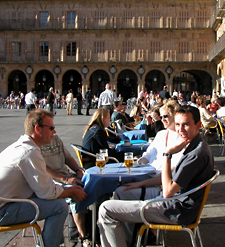 |
| From NMT Images |
Salamanca sits at the edge of a greening plane, dominated by a skyline of domed cathedrals and dun-colored walls, embracing the town in a timeless medieval clinch.
The Spaniards call Salamanca “the soul of the Spanish nation," because it's the birthplace of Castilian,the Spanish language.
Walk Salamanca's streets. It’s the only way to experience the layers of Roman, Visigothic, Islamic cultures that shaped the city for centuries.
“starting point” has to be the sprawling University, a 13th century masterpiece that still gives off a powerful sense of history and learning. Today, beautiful students stride with youthful confidence, chatting on smart phones as they pass beneath imposing arches where some of the world's greatest scholars walked and taught.
Look into the perfectly preserved classroom of Friar Luis de Leon. The hapless but gutsy priest infuriated the Spanish Inquisition by translating forbidden books, was arrested in his classroom. Tortured and imprisoned for five years by the Inquisition, he was eventually released, and when he was he walked back into to his classroom, he resumed teaching with the words all of Salamanca will never forget: “Como decimos ayer.” As we were saying yesterday.
Throughout the narrow,twisting streets of this walled city, plazas and parks peek out from towering church buttresses.
They're magically tucked away in the shadow of a cathedral or defunct convent, centers of conversation and laughter.
Stop at cafe for a taste of Salamanca’s salty, tangy cheeses, exceptional local sausages and smoked meats with a glass of the local, inexpensive red wine from Rioja.
You'll always hear the strains of a sad, solitary violin from a musician somewhere in the maze, echoing off the cloistered homes and curving walls.
By night, Salamanca is a different place. The vaulted arches and multi-leveled, intricately carved spires are tinted with a pink glow from artfully arranged lights that highlight the ornate designs and architecture.
Clusters of costumed dancers, castanets snapping, spill from a restaurants, performing a local dance to the delight of passersby.
The restaurants and cafes are open until very late, and since there are no characterless chain hotels, you'll stay at one the boutique accommodations on any side street or plaza. Learn a little Spanish. Not much English is spoken here, but in this old and proud city, manners and simple courtesies matter more.
You might enjoy this Walking Tour of Salamanca before you go. But do go!
Comments
Regarding the pronunciation: This is the Arabic for "Red" from which the "palace" gets its name. أحمر
Talk about being pedantic: the first letter is " Al" the second is the pure "H"sound. The entire word actually reads alhhmr, or "Red". I included the original sound in my narration. It may not be, however, how most in Spain say the word.
Entonces, asi es la vida and gracias por su observaciones!
cheers
K
Regarding the pronunciation: It, like many Spanish words (Olives; Oil, Guadalquivir -Wadi al Kabir) are from the Arabic
Al Hambra is, in Arabic, "the red" and the "H" is an aspirated "H" very much sounded
But thanks for writing in and sorry for the mistake
Kaleel
Thanks for writing
KS